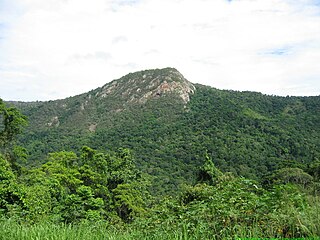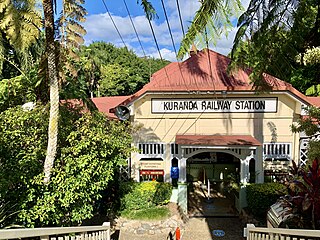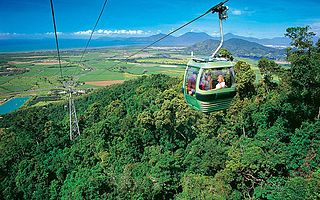Related Research Articles

The didgeridoo is a wind instrument, played with vibrating lips to produce a continuous drone while using a special breathing technique called circular breathing. The didgeridoo was developed by Aboriginal peoples of northern Australia at least 1,000 years ago, and is now in use around the world, though still most strongly associated with Indigenous Australian music. In the Yolŋu languages of the indigenous people of northeast Arnhem Land the name for the instrument is the yiḏaki, or more recently by some, mandapul. In the Bininj Kunwok language of West Arnhem Land it is known as mako.

Barron Gorge National Park is a protected area in the Cairns Region, Queensland, Australia. It lies predominantly within the locality of Barron Gorge.

Mark Atkins is an Australian Aboriginal musician known for his skill on the didgeridoo, a traditional instrument.
Djalu Gurruwiwi, written Djalu, was a Yolngu man and leader from Arnhem Land in northern Australia. He was globally recognised for his acquired skill as a player, maker, and spiritual keeper of the yiḏaki, also referred to as the didgeridoo. As a respected artist with many of his works in several galleries, he aimed to spread his culture and traditions past his own community.

Indigenous music of Australia comprises the music of the Aboriginal and Torres Strait Islander peoples of Australia, intersecting with their cultural and ceremonial observances, through the millennia of their individual and collective histories to the present day. The traditional forms include many aspects of performance and musical instrumentation that are unique to particular regions or Aboriginal Australian groups; and some elements of musical tradition are common or widespread through much of the Australian continent, and even beyond. The music of the Torres Strait Islanders is related to that of adjacent parts of New Guinea. Music is a vital part of Indigenous Australians' cultural maintenance.

Kuranda is a rural town and locality on the Atherton Tableland in the Shire of Mareeba, Queensland, Australia. In the 2016 census, Kuranda had a population of 3,008 people. It is 25 kilometres (16 mi) from Cairns, via the Kuranda Range road. It is surrounded by tropical rainforest and adjacent to the Wet Tropics of Queensland World Heritage listed Barron Gorge National Park.

Charlie McMahon is an Australian didgeridoo player. The founder of the group Gondwanaland, McMahon was one of the first non-Aboriginal musicians to gain fame as a professional player of the instrument.
Coloured Stone is an Aboriginal Australian band whose members originate from the Koonibba Mission, west of Ceduna, South Australia. The band performs using guitar, bass, drums, and Aboriginal instruments – didjeridu, bundawuthada and clap sticks – to play traditional music.

Skyrail Rainforest Cableway is a 7.5-kilometre (4.7 mi) scenic tourist cableway running above the Barron Gorge National Park, in the Wet Tropics of Queensland’s World Heritage Area in Australia. It operates from the Smithfield terminal in Cairns to the Kuranda terminal on the Atherton Tableland. It has won more than 25 awards.

Alan Dargin was an indigenous Australian musician and songwriter known for being a didgeridoo player. He grew up in Wee Waa and started learning the instrument at age five from his grandfather and other Wiradjuri elders. His signature instrument was over a hundred years old and was made from a blood wood eucalypt. He received his secondary education at St Pius X High School, Newcastle.
Djabugay is an endangered Australian Aboriginal language spoken by the Djabugay people with 46 native speakers at the 2016 census. The Djabugay language region includes Far North Queensland, particularly around the Kuranda Range and Barron River catchment, and the landscape within the local government boundaries of the Cairns Regional Council.
Clifton Beach is a coastal suburb in the Cairns Region, Queensland, Australia. In the 2021 census, Clifton Beach had a population of 3,192 people.

The Djabugay people are a group of Australian Aboriginal people who are the original inhabitants of mountains, gorges, lands and waters of a richly forested part of the Great Dividing Range including the Barron Gorge and surrounding areas within the Wet Tropics of Queensland.

David Williams is an Australian musician and artist.
The history of Cairns in Queensland, Australia, is a transition of a port from a shanty town to a modern city, following an uncertain start because of competition from the newly created neighbouring community of Port Douglas. A succession of major work projects, institution establishments and direct involvement in world enterprise accelerated the settlement's development.

Henrietta Marrie is a Gimuy Walubara Yidinji elder, an Australian Research Council Fellow and Honorary Professor with the University of Queensland.
Djaambi were an urban rock band formed in 1989 by Richard Frankland (ex-Interaction) on lead vocals and saxophone, with both Aboriginal and white members. Initially a ten-piece, they had a variable line-up and sometimes had 15 performers. The word, djaambi, is "brother" in an Aboriginal language. The group released a self-titled album in 1990 and supported Prince on his Australian Tour in 1992.
Ash Dargan is an indigenous Australian didgeridoo player. He is a member of the Larrakia people but did not find out about his aboriginality until he was 21. He teaches and performs all over the world. He is a former member of Coloured Stone, appearing on their 1999 album Rhythm of Nature.

Gnosis is the fourth album by the British progressive rock band, Gnidrolog. The album's title, Gnosis, means divine or spiritual knowledge and understanding. It is their third studio album and the first to be recorded in 27 years. The album was mostly recorded at Select Sound Studios, Cairns, Australia, where it was engineered and produced by Nigel Pegrum. "Repent Harlequin", "Two Helens" and the title track were all recorded at Music City Studios, London, engineered by Joe Suarez and produced by Nessa Glen, in courtesy of Sarastro Music. The album was mostly published by Kempyre Music, except "Two Helens", which was published by Sarastro Music. Chris Copping of Procol Harum played his Hammond B3 Organ for a couple of tracks, which were recorded in Woodstock Studios, Melbourne and engineered by Tim Dudfield. Post production is credited to David J Burrows and Stewart Goldring. The album was mastered by David J Burrows at Disques rue Bis. The album is noted to be eclectic not only for its transcontinental recording but also for the use of traditional instruments such as the Australian aboriginal, didgeridoos. The album marks the band's comeback, which had also prompted the release of the Live 1972 album. In order to release some of the Goldring brothers' original material, the album was a renewed cooperation with the other 1970s Gnidrolog members, with the addition of Rick Kemp of Steeleye Span and Nessa Glen.

Kewarra Beach is a coastal suburb of Cairns in the Cairns Region, Queensland, Australia. In the 2016 census, Kewarra Beach had a population of 5,652 people.
References
- 1 2 Bush, John. "David Hudson". AllMusic . All Media Guide . Retrieved 4 May 2016.
- 1 2 3 Carter, Denise (30 January 2015). "David Hudson is a musician, artist, actor and presenter on the world stage but still calls Cairns home". The Cairns Post . News Corp Australia . Retrieved 4 May 2016.
- 1 2 "Indigenous Tourism". Skyrail News. Skyrail Rainforest Cableway. February 2012. Retrieved 4 May 2016.
- ↑ Reid, Paul (12 August 1990). "Tribal Name and Pride Find an Outlet on Stage". The Canberra Times . 64 (20, 211): 24. Retrieved 3 May 2016– via National Library of Australia.
- ↑ Greene, Paul D.; Porcello, Thomas (2010). Wired for Sound: Engineering and Technologies in Sonic Cultures: Music Culture. Wesleyan University Press. pp. 86–89, 95–100. ISBN 978-0-81957-062-8.
- ↑ Have Didge will Travel YouTube
- ↑ TEDxJCUCairns
- ↑ "Photo Gallery:The Official Opening of the Sir John Monash Centre". Sir John Monash Centre. Retrieved 20 August 2018.
- ↑ Hudson, David (1994), Rainbow serpent : music for didgeridoo & percussion, Celestial Harmonies, retrieved 4 May 2016– via National Library of Australia Note: Recorded at the Timeroom (Tucson, Arizona); bush sounds recorded in Laura, Queensland.
- ↑ Hudson, David (2006), The very best of David Hudson, Indigenous Australia, retrieved 4 May 2016– via National Library of Australia Note: Previously released material. "The very best of Australia's world music rhythms" – Container. "Musical stories from this multi platinum world music artist" – Container.
- ↑ "David Hudson – Discography". Creative Spirits. Archived from the original on 31 October 2010. Retrieved 4 May 2016.